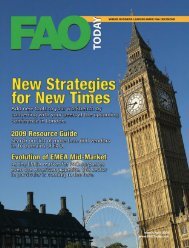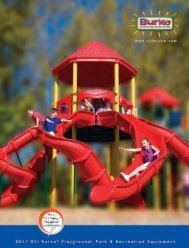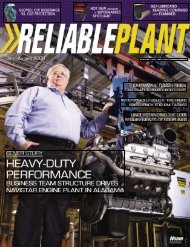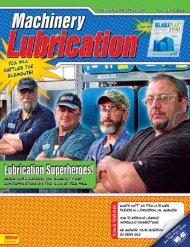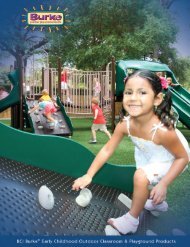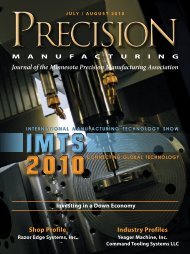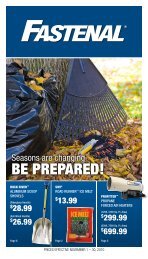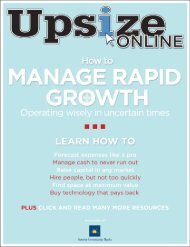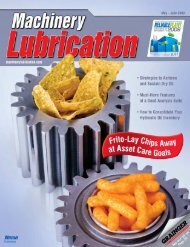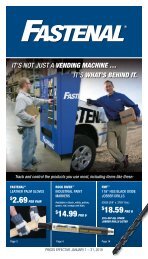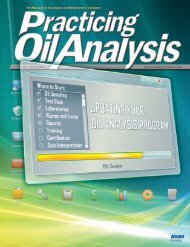Machinery Lubrication July August 2008
Machinery Lubrication July August 2008
Machinery Lubrication July August 2008
You also want an ePaper? Increase the reach of your titles
YUMPU automatically turns print PDFs into web optimized ePapers that Google loves.
obtained from advances in the program, which will keep<br />
everyone focused and provide justification for continued<br />
improvement. Having defined action plans for unmet goals will<br />
facilitate the success of the program.<br />
11. Safety Practices<br />
It goes without saying that safety is the top concern for any<br />
industrial facility. Many initiatives designed to improve<br />
machinery reliability can actually contribute to<br />
improved safety as well. Leak remediation,<br />
proper handling of materials, spill controls and<br />
drain interval optimization can potentially<br />
reduce the frequency of occurrence of lubricant<br />
related-accidents. Proper training for the<br />
potential hazards associated with the handling<br />
of lubricants can further reduce health risks.<br />
About the Author<br />
Jarrod Potteiger is a leading consultant and trainer for Noria Reliability<br />
Solutions. As technical services director, he has helped pioneer Noria’s<br />
world-class <strong>Lubrication</strong> Process Design (LPD) and other services. He has<br />
also provided training and mentorship to other consultants and helped<br />
to construct a design team which provides the highest level of service in<br />
our industry.<br />
He has trained hundreds of maintenance and reliability professionals in<br />
Noria’s public and on-site seminars and has presented at a variety of technical<br />
conferences. Contact Jarrod at jpotteiger@noria.com.<br />
12. Continuous Improvement<br />
Success is a journey, not a destination. Even<br />
if a lubrication program was perfectly designed<br />
and implemented, it would still require changes<br />
from time to time. Changing conditions such<br />
as production demands, new equipment and<br />
new technologies require some aspects of the<br />
program to undergo continuous improvement.<br />
Methods should be in place to perform root<br />
cause analysis on machine failures not<br />
predicted by oil analysis as well as recurring<br />
premature failures. Recurring failures should<br />
be addressed by considering alternate lubricants<br />
or machine design modifications to<br />
eliminate or resist the suspected root cause.<br />
Defining an action plan to achieve excellence<br />
in a lubrication program can be a<br />
daunting task and requires an initial survey<br />
to gain perspective. Some organizations may<br />
have the desire and qualified personnel to<br />
perform such an audit, while others may hire<br />
outside consultants.<br />
The spider diagram is a valuable tool for<br />
assessing and visually representing the<br />
current state of the program. When scaled<br />
with an appropriate weighting system, it can<br />
indicate the primary areas of focus for<br />
resource allocation. After the initial assessment,<br />
this method can be used for<br />
subsequent evaluations which will indicate<br />
the effectiveness of the current strategies and<br />
highlight the deficiencies.<br />
<strong>Machinery</strong> <strong>Lubrication</strong> machinerylubrication.com <strong>July</strong> - <strong>August</strong> <strong>2008</strong> 17



